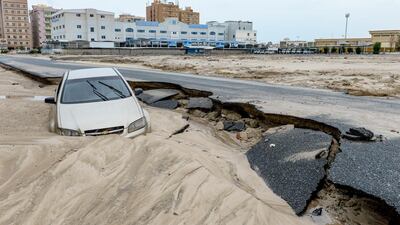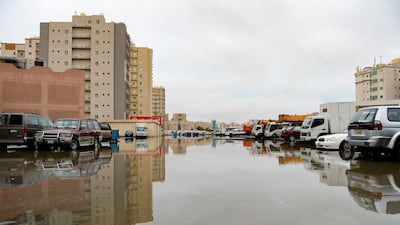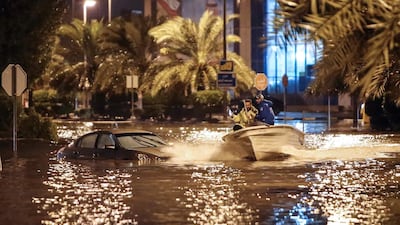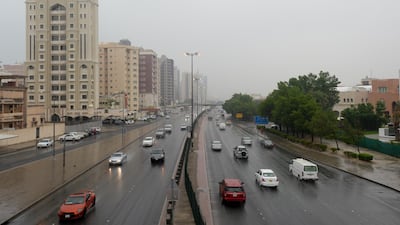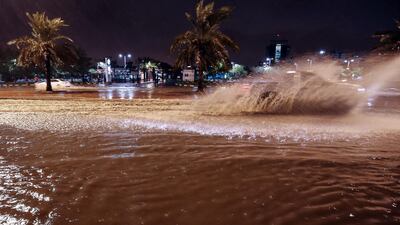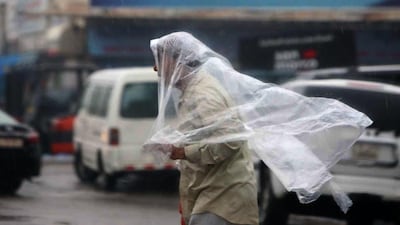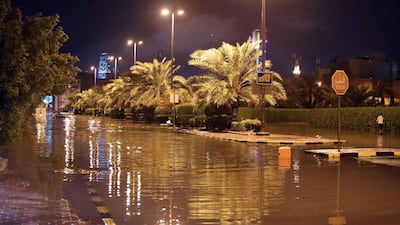Saudi Civil Defence urged residents in Jeddah to stay indoors as a deadly storm bringing heavy rain is expected in the Red Sea coastal city over the weekend.
Thirty people have been killed because of the weather in recent days, the Civil Defence said.
Between Saturday and Tuesday morning, 10 people died in Makkah, five in Al Baha, three each in Aseer and the Eastern regions, two each in Hayel, Jazan and Tabouk and one each in Riyadh, Al Jouf and Najran.
Another 3,865 people were evacuated from areas in danger of floods from the heavy downpour expected in the coming days.
Tents have been set up for temporary accommodation for 2,000 people in Al Jouf.
___________
Middle East weather
Deadly flash floods stir up storm in Kuwait's cabinet
Eight months of rain in one da in UAE
Death toll from Jordan floods rises to 13
___________
Kuwait has temporarily suspended flights to and from its international airport due to heavy rain.
Air Traffic at the Kuwait International Airport has been temporarily suspended, the Directorate General of Civil Aviation said.
A GCC national airlines pilot said that the redirection of planes has been a result of the closure of the airport and facilities due to security measures. The General Aviation Authority in Kuwait is trying to ensure the safety of passengers amid rain and heavy winds.
“The airport is closed so [the planes] can’t come back, the ones that got redirected to Dammam and Riyadh are the flights on the way back to Kuwait but couldn't land before the airport shut down,” the pilot, who asked to remain anonymous, said.
Kuna, the Kuwaiti state news agency said inbound flights are being redirected to Damman in eastern Saudi Arabia and Manama, the capital of Bahrain.
But as flood warnings were being issued, a different storm was brewing in the inner halls of Kuwaiti parliament.
The flooding has become another stark example of the Gulf state's sub-par infrastructure which has been riddled by failures of the Ministry of Public Works to implement reform projects, let alone updating the public.
“We are ready for the rain,” Ahmed Al Hassan, the head of Road Authority in Kuwait declared in September when describing the country’s road water drainage system.
But that was only true for some parts of Kuwait.
Other areas flooded heavily, causing 100 million Kuwait dinars (Dh1.2 billion) in damage. One person was killed and it prompted the government to take extreme measures.
The Cabinet of Ministers suspended work and schools on Thursday for the second day in a row. Kuwait’s stock market closed on Wednesday as well.
The damage has also led the Minister of Public Works, Hussam Al Roumi to resign.
Despite submitting his resignation, the minister has continued to function in his role. On Wednesday during an emergency parliament session, he urged all government sectors to focus on addressing the heavy rains to come.
He did not, however, shy away from launching an investigation into the matter, saying that “does not mean we will not hold those accountable, and we will punish those who have defaulted”.
An investigation is currently underway set up by a neutral committee that will then redirect their results to Kuwait’s parliament to take the necessary legal actions.
The parliament has formed a committee to investigate the reason behind the damages caused by the flooding in Kuwait.
This has easily been a once-in-a-lifetime storm. In the last 24 hours, 138mm of rain fell on Kuwait, more than it receives on an average year.
Kuwait mobilised the civil defense units and the National Guard to drain flooded roads by sunrise.
The problem is not unique to Kuwait, the UAE flooded heavily after having experienced a smaller storm, while Jordan's flooding has been deadly.
The problem is likely to lie either in respective GCC government’s shortcomings in providing flood-ready measures or their reluctance to identify flood-readiness as a major concern for restructuring.
Jeddah has historically been subject to intense flooding. Floods killed 123 people in Jeddah in 2009 and about 10 people two years later.
The Saudi Civil Defence said eight committees were set up to assess the material damage to properties.
The Directorate of Civil Defence in the Eastern Province cautioned citizens and residents in all governorates of the region to take precautionary measure.
“Do not congregate in low areas, or in places that are likely to flood,” a statement on Saudi Arabia’s state news agency said.
The official spokesman of the eastern region, Civil Lt. Col. Abdulhadi Al-Shahrani, urged citizens and residents to abide by the safety obligations through the Civil Defense website.
He told residents to avoid valleys and to avoid sources of electricity, such as power stations or any signs of open circuitry.
Khafji, a Saudi city just an hours drive south from Kuwait City, has ordered public workers to assess the damage caused by rainfall this week.
Last year two died in Jeddah from electrocution as heavy rains fell on the west coast cities of Saudi Arabia.
The storm has also extended to parts of Jordan where heavy rainfall has caused flash floods in different areas of the country.
The floods have killed at least 34 showing cracks in Jordan's infrastructure. Officials deployed rescue teams to evacuate more than 1,000 caught in flash floods less than two weeks after a storm killed 21 in the Dead Sea vicinity.

